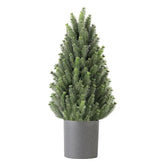What does injection molding mean in the context of an artificial Christmas tree?
When it comes to artificial Christmas trees, the term "injection molding" is frequently heard. But what does it actually mean, and why is this process so popular? In this article, we take a closer look at the injection molding process and why it plays a crucial role in the production of realistic artificial Christmas trees.
What is injection molding?
Injection molding is a manufacturing process in which liquid plastic is poured into a mold. This mold is designed to replicate the exact structure and appearance of real fir branches. After the plastic has cooled and solidified, the mold is opened and the finished product – in this case, a realistic branch or needle – is removed.
Why is injection molding so popular for artificial Christmas trees?
What makes injection-molded Christmas trees special is their exceptionally high level of detail. Injection molding is often done with PE plastic. PE is a plastic, more precisely polyethylene. Polyethylene is a widely used thermoplastic that finds application in many products due to its flexibility, durability, and moisture resistance. In the production of Christmas trees, PE (polyethylene) is used for the branches because the injection molding process allows for the creation of realistically shaped branches that mimic the look and feel of real ones. Compared to conventional PVC (polyvinyl chloride) branches, PE branches have a three-dimensional structure and therefore appear much more realistic.
The branches and needles not only look deceptively real, but they also feel that way. This makes them a popular choice for anyone wanting a tree that looks as natural as possible. Unlike traditional PVC trees, where the needles are often flat and glossy, injection-molded trees have a matte finish and a three-dimensional structure that almost perfectly mimics real fir trees. To offer a realistic look at an affordable price, many Christmas tree manufacturers now offer PVC-PE hybrid trees. These trees use realistic-looking PE branches at the tips, while the branches at the back are filled with PVC to give the tree more body.
The dark green branches in the picture are made of PVC material, while the light green parts are made of PE material and were produced using injection molding.
Salcar all-PVC Christmas tree:
Salcar Full PE Christmas Tree:
Salcar 180/210/240cm Artificial Christmas Tree, Nordmann Fir, With 762/1080/1576 PE Tips
Salcar PVC+PE Mixed Christmas Tree:
The advantages of an injection-molded Christmas tree
Realistic appearance: Thanks to the precise shaping, the branches and needles look deceptively like a real tree.
Durability: Because the plastic is robust and durable, injection-molded trees can be used for many years.
No needles: Unlike real Christmas trees, injection-molded trees do not lose needles, making them particularly easy to care for.
The disadvantage of injection-molded trees
The only downside to these realistic trees is often the price. Because they are more complex to manufacture and use higher-quality materials, injection-molded Christmas trees are generally more expensive than simpler PVC models. However, for many, the investment is worthwhile, especially considering that these trees can be used for many years.
Conclusion
Injection molding is the key to exceptionally realistic artificial Christmas trees. It offers the possibility of owning a tree that is almost indistinguishable from a real one in appearance and feel – with maximum durability and ease of care. So, if you're looking for an artificial Christmas tree that will last for years, an injection-molded tree is definitely worth considering.












